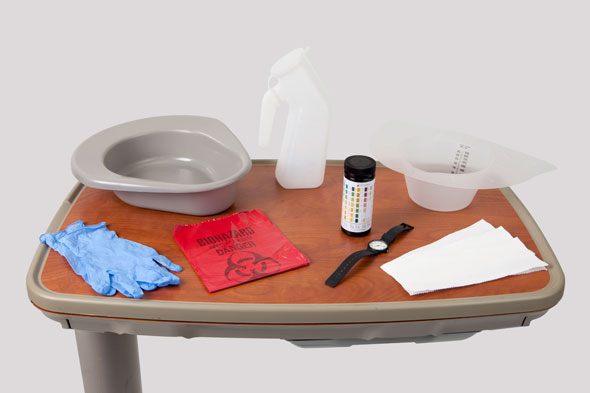Specimen Collection
Select a Skill:
- » Collecting a Midstream Urine Specimen
- » Performing Fecal Occult Blood Testing
- » Performing Gastric Occult Blood Testing
- » Collecting a Sputum Specimen
- » Collecting a Specimen for Wound Culture
- » Performing Blood Glucose Testing
- » Screening Urine for Chemical Properties
Take the Review Test:

Safety
- Adapt to the patient’s needs and abilities to perform and/or participate in specimen collection procedures.
- Follow standard precautions when collecting specimens of blood or body fluids.
- Follow your agency’s procedure for medications or dietary intake that may result in deviation from normal values.
- Follow precautions for collecting specimens from patients who are in protective isolation.
Equipment
(Roll cursor over items to see labels)

Bedpan, urinal or specimen hat
Bedpan, urinal or specimen hat
Bedpan, urinal or specimen hat
Watch with second hand or digital counter
Reagent test strips
Test strip color chart
Paper towels
Clean gloves
Delegation
The skill of screening urine for chemical properties may be delegated to nursing assistive personnel (NAP). Be sure to inform NAP of the following:
- Explain how to obtain the specimen correctly, such as before meals or as a double-voided specimen.
- Instruct NAP to report to you the results of the test, including observation of any odor, blood, or mucus in the urine specimen.
Preparation
- Check the provider’s orders. Determine if a double-voided specimen is needed for glucose testing.
- If required, ask the patient to void and then drink a glass of water.
- Gather the necessary equipment, including a watch with a second hand or digital display.
Follow-up
- When appropriate, discuss the test results with the patient.
Documentation
- Record the results immediately on the appropriate testing flowsheet.
- Report the reading to the health care provider.
Review Questions
1. Testing with a urine reagent test strip shows that a patient’s urine is positive for protein, negative for glucose and blood, and has a pH of 8.2. What will the nurse do in response to these results?
 Check the medical record for further instructions from the health care provider.
Check the medical record for further instructions from the health care provider. Notify the health care provider of the results of the test.
Notify the health care provider of the results of the test. Retain the sample, and retest it to confirm the results.
Retain the sample, and retest it to confirm the results.  Obtain a double-voided urine specimen.
Obtain a double-voided urine specimen.
2. Which action is necessary for an accurate chemical reaction when testing urine with a reagent test strip?
 Hold the test strip in the urine for 10 seconds before completing the test.
Hold the test strip in the urine for 10 seconds before completing the test.  Compare the test strip vertically against the container.
Compare the test strip vertically against the container.  Wear clean treatment gloves while handling the strip.
Wear clean treatment gloves while handling the strip.  Keep the test strip horizontal while timing the process.
Keep the test strip horizontal while timing the process.
3. Which statement will the nurse make to nursing assistive personnel (NAP) when delegating urine glucose testing with a reagent strip for a patient with type 2 diabetes?
 “Be sure to wear sterile gloves when testing the urine.”
“Be sure to wear sterile gloves when testing the urine.”  “Make sure urine sits for a full minute post void to read for ketones.”
“Make sure urine sits for a full minute post void to read for ketones.”  “Check our supply of urine glucose test strips.”
“Check our supply of urine glucose test strips.”  “Don’t forget to get a double-voided specimen when you test the patient’s urine.”
“Don’t forget to get a double-voided specimen when you test the patient’s urine.”
4. What is a double-voided urine specimen?
 Any urine sample that is not contaminated with either feces or toilet tissue
Any urine sample that is not contaminated with either feces or toilet tissue  A second urine specimen taken about 30 minutes after the patient voids
A second urine specimen taken about 30 minutes after the patient voids  The first of two samples obtained from the patient’s first voiding of the day
The first of two samples obtained from the patient’s first voiding of the day  A urine sample divided into two clean containers to be tested separately
A urine sample divided into two clean containers to be tested separately
5. Which action is performed initially when using a reagent strip to test the urine of a patient with type 1 diabetes for glucose?
 Apply clean treatment gloves.
Apply clean treatment gloves. Verify the patient using two patient identifiers.
Verify the patient using two patient identifiers. Discard the urine after the patient voids.
Discard the urine after the patient voids. Encourage the patient to drink a glass of fluid.
Encourage the patient to drink a glass of fluid.
You have completed the Review Questions for this skill. To take the Review again select the Start Over button. To proceed to another skill select from the dropdown menu. Select the Home or Back button to proceed to the next section.

